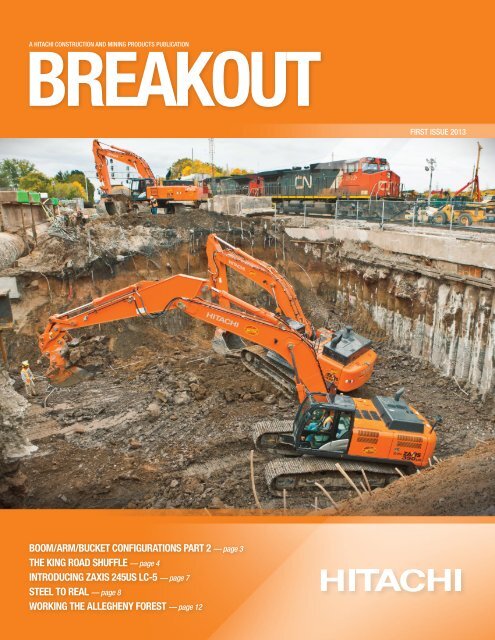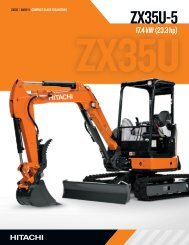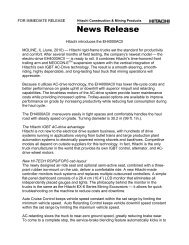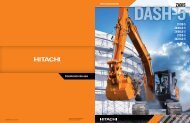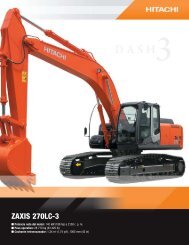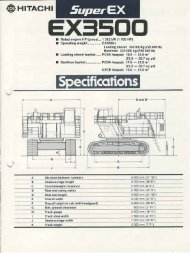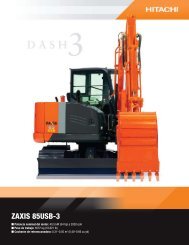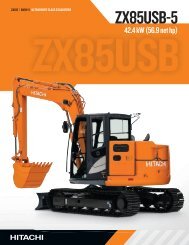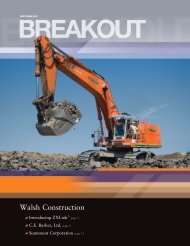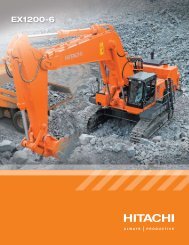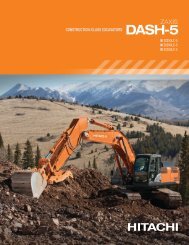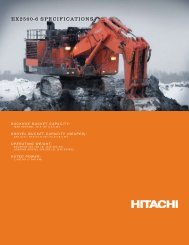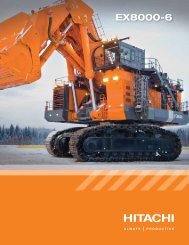Issue 1 - Hitachi
Issue 1 - Hitachi
Issue 1 - Hitachi
You also want an ePaper? Increase the reach of your titles
YUMPU automatically turns print PDFs into web optimized ePapers that Google loves.
A HITACHI CONSTRUCTION AND MINING PRODUCTS PUBLICATION<br />
BREAKOUT<br />
FIRST ISSUE 2013<br />
BOOM/ARM/BUCKET CONFIGURATIONS PART 2 — page 3<br />
THE KING ROAD SHUFFLE — page 4<br />
INTRODUCING ZAxIS 245US LC-5 — page 7<br />
STEEL TO REAL — page 8<br />
WORKING THE ALLEGHENy FOREST — page 12
ON<br />
the<br />
INSIDE<br />
HitacHi is growing!<br />
As you’ve seen in our ads, “We Dig. We Haul.<br />
That’s All.” To reinforce our commitment to excavator<br />
and rigid-frame haul-truck excellence, we are signifcantly<br />
expanding two of our manufacturing plants<br />
here in North America.<br />
In North Carolina, we’re investing over $97 million<br />
in our Kernersville plant, and will be adding over 300<br />
new jobs over a four-year period to bolster the current<br />
workforce of 743. We are purchasing approximately<br />
60 acres of land adjacent to the current<br />
facility, buying a building that will be expanded for<br />
manufacturing and warehouse space, and expanding<br />
the existing factory with state-of-the-art technology.<br />
This investment will increase capacity on currently<br />
manufactured machine models, plus add production<br />
capability for additional midsized excavator models.<br />
In Guelph, Ontario, we are adding 13,294 m 2<br />
(143,100 sq. ft.) to our <strong>Hitachi</strong> truck plant. It will<br />
manufacture 190–300-metric-ton loading-capacity<br />
rigid-frame haul trucks for sale primarily in North,<br />
Central, and South America. The plant will also<br />
continue to manufacture EH1100-3 and EH1700-3<br />
trucks for global distribution. The workforce should<br />
double in size, and output should be raised to 280<br />
units a year.<br />
Additionally, <strong>Hitachi</strong> in Japan is expanding two<br />
existing plants and will construct more as necessary<br />
to signifcantly boost production capacity for large<br />
and ultra-large hydraulic excavators and haul trucks.<br />
For more information about the Kernersville plant<br />
expansion, be sure to read the article in this issue.<br />
We like orange! And it’s obvious you do, too, since<br />
you are making these investments possible. Thanks.<br />
POWERED BY THEIR<br />
<strong>Hitachi</strong> Dash-5 Excavators are powered by<br />
fuel-efðcient Isuzu Interim Tier 4-certiðed<br />
engines. As a result, the Dash-5s are more<br />
productive than ever. Operators will also<br />
like them for their wider cabs with improved<br />
visibility. See your <strong>Hitachi</strong> dealer today and<br />
discover why specializing in excavators<br />
results in such reliable machines.<br />
See your <strong>Hitachi</strong> dealer today about the<br />
exciting new crop of Dash-5 excavators.<br />
www.hitachiconstruction.com<br />
Kelly Granatier, Director, Sales, <strong>Hitachi</strong> Division
HITACHI TECH TIPS<br />
Which boom/arm/<br />
bucket configuration<br />
is right for you Part 2<br />
hitachi construction excavators<br />
typically offer one boom length<br />
and two or three arm lengths, depending<br />
on the excavator size.<br />
An underground contractor and<br />
basement digger will usually buy a long<br />
arm for reach and the best productivity.<br />
A cross-country pipeliner or a landclearing<br />
contractor will buy medium<br />
arms for stability and the best productivity.<br />
A mass-excavation contractor<br />
will buy a short arm for arm force and<br />
the best productivity.<br />
The best way to calculate the differences<br />
in crowd and arm forces between<br />
booms is by referring to the spec sheet<br />
or operator’s manual. The difference<br />
will be listed under arm forces.<br />
There are many things to consider<br />
when sizing the bucket — application,<br />
material density, production required,<br />
etc. The best advice is to consult the<br />
dealer and the product literature. The<br />
literature will give a basic idea for the<br />
bucket size based on material density<br />
and arm length. However, if a coupler<br />
or thumb has been installed on the<br />
machine, the bucket might need to be<br />
downsized to maximize performance.<br />
If the customer is loading trucks from<br />
a bench with limited reach, a larger<br />
bucket might be a consideration. Talk<br />
with the dealer or a product specialist<br />
to determine the best confguration to<br />
meet the contractor’s needs.<br />
Impact of boom and arm<br />
lengths on attachments<br />
Attachments can be installed on<br />
excavator depending on the weight<br />
of the attachment and the hydraulic<br />
fow needed to operate it. Adding an<br />
attachment is like sizing a bucket for<br />
the excavator, and depends on weight<br />
and lift over the side.<br />
<strong>Hitachi</strong> offers super-long fronts for<br />
for the midsize ZX210LC-5, 250LC-5,<br />
290LC-5, and 350LC-5 Excavators.<br />
The package comes with new longer<br />
boom and arm, plus extra counterweight,<br />
new lift and maintenance<br />
charts, and new operational labels.<br />
These long fronts are used in special<br />
applications such as handing green<br />
(light) material or cleaning ditches.<br />
They also are used to place rip-rap,<br />
and contractors appreciate the reach in<br />
these applications.<br />
Here are a few examples of jobs where<br />
super-long-front excavators are used:<br />
n Handling rip-rap and placement on<br />
slopes or in the bottom of waterways<br />
n Cleaning eroded material out of ponds<br />
or along riverbanks<br />
n Handling green material such as glass<br />
in swampy areas<br />
n Unloading barges or loading trucks<br />
n Finishing steep slopes<br />
n Dredging lakes, rivers, ponds, or drainage<br />
ditches; casting material out and<br />
away from the water and placing it to<br />
dry or be hauled away<br />
n Demolition used for reach and sometimes<br />
with a concrete crusher<br />
n Attachment for mowing, mulching, or<br />
brush cutting for weed control and<br />
drainage management<br />
n Handling construction materials such<br />
as ready-mix concrete, gravel, or/<br />
and sand<br />
n Scrap handling<br />
n Reaching confined areas like across<br />
the pipe on cross-country pipeline<br />
jobs<br />
Most super-long-front excavators<br />
are equipped with lightweight buckets<br />
that are usually wide for cleaning<br />
purposes, or with attachments for<br />
special operations.<br />
Super-long-front excavators should not<br />
be used for:<br />
n Excavating heavy/hard material<br />
n Sweeping or swinging sideways to<br />
level ridges/high areas<br />
n Extreme side loading<br />
n Tamping to compact or using the<br />
cutting edge on the bucket to break<br />
hard material<br />
Contractors who dig around water<br />
should be careful not to dig under the<br />
machine and slide into the water.<br />
If you have any questions about the<br />
best combination of arm length and<br />
front attachments for your next project,<br />
contact your local <strong>Hitachi</strong> dealer.<br />
3
The King Road<br />
Shuffle<br />
Grade crossing to underpass in 72 hours<br />
afrst-of-its kind fast-track<br />
event involving three outstanding<br />
Toronto-based contractors and a<br />
slew of <strong>Hitachi</strong> excavators took place<br />
over Canada’s Thanksgiving weekend.<br />
Over the course of three hectic October<br />
days, a very busy, four-track railroadgrade<br />
crossing was transformed into a<br />
much safer roadway underpass. Called<br />
the King Road Grade Separation, the<br />
project was a joint venture between the<br />
City of Burlington, Ontario, a Toronto<br />
suburb, and the Canadian National<br />
Railway (CNR). It was budgeted to<br />
cost C$24,515,000.<br />
The big idea<br />
Since CNR is the primary/almost-only<br />
east-west rail transportation across<br />
Canada, it was critical that disruptions<br />
of service be held to a minimum.<br />
So the consulting team of Hatch<br />
Mott MacDonald and AMEC Earth<br />
and Environmental Consulting Engineers<br />
promoted four ideas in order to<br />
do as much work as possible before<br />
the Thanksgiving weekend. First, divert<br />
all possible electrical, telephone, and<br />
drainage services while not disturbing<br />
the rail or roadways. Second, excavate<br />
an area beside the railway, in line with<br />
the ultimate underpass and parallel to<br />
the existing roadway. Third, build the<br />
new roadway as far as possible, short<br />
of the actual underpass. And fourth,<br />
pre-build the concrete underpass<br />
structure, slide it into place under the<br />
railway route at the appropriate time,<br />
then immediately reinstall the tracks.<br />
“The scope of our project,” explains<br />
Ennio Liorti, President of Metric<br />
Contracting Services Corporation,<br />
“was to remove the rail track, excavate<br />
approximately 8000 m 3 (10,464 cu.<br />
yd.), and build the concrete pads for<br />
the underpass bridge to slide on into<br />
place. Another company did the actual<br />
jacking of the structure. And once it<br />
was in place, we did the backflling and<br />
CNR reinstalled the tracks”<br />
Sounds straightforward enough, but<br />
the contract included a multitude of<br />
restrictions and a very real-time deadline.<br />
Start time was 11:59 Friday night,<br />
and it all had to be fnished by 11:59<br />
Because rail traffic is nearly nonstop, the<br />
underpass structure was built beside the track<br />
to be slid in place at the opportune time.<br />
Excavation under the railway and all<br />
construction had to be done over a long<br />
holiday weekend.<br />
Rail traffic resumed before deadline.<br />
4
Ennio Liorti, President, Metric Contracting<br />
Services Corporation, Brampton, Ontario.<br />
Monday night in order to handle the<br />
frst roar of the early trains. The result<br />
was a very intensive 72 hours.<br />
What does it take to move<br />
a Five-million-PoUnd bridge<br />
The concrete underpass Dufferin<br />
Construction constructed weighed<br />
2 395 008 kg (5,280,000 lb.) and<br />
had to be moved 27 meters (90 ft.)<br />
to be precisely placed not only under<br />
the railway but also in line with the<br />
new roadway. The way it was moved<br />
was amazing to watch. An incredible<br />
amount of work had to be completed<br />
within a 72-hour period which included<br />
the bridge move.<br />
Metric used their ZX350LC-5 with<br />
a special attachment to lift the existing<br />
rail-track sections one by one — with<br />
the wood ties in place — in a numbered<br />
sequence. They then trolleyed them<br />
back to a secure location, keeping them<br />
in the proper order. At the same time,<br />
other Metric-owned <strong>Hitachi</strong> excavators<br />
began digging away at the edges of<br />
the railway. The spoil was hauled to a<br />
nearby spot by their articulated trucks<br />
for reuse in their backflling effort.<br />
“We were notifed about three weeks<br />
before the project start date that we<br />
had won the bid for our part,” explains<br />
Liorti. “So, within those three weeks,<br />
we needed to assemble about 25 pieces<br />
of equipment and organize 30 employees<br />
per shift — divided between operators,<br />
laborers, and truck drivers —<br />
5
for a total of about 60 people. We<br />
could divert most of our equipment<br />
needs from other jobs for the long<br />
weekend, but we did rent a couple<br />
of wheel loaders.”<br />
After the excavation was completed<br />
in the late afternoon hours of Saturday,<br />
the trolley pads were set up and<br />
poured. They had to be extremely level,<br />
and holes had to be precisely placed for<br />
use by hydraulic jacks that would help<br />
move the underpass. “Another company,<br />
Western Hydraulics, had the bid<br />
for actually moving the structure. Our<br />
goal was to provide the level pad for it<br />
to move on and the correct bore holes<br />
for their machines to sink their pins<br />
for traction.”<br />
Using hydraulic jacks, with highpressure<br />
air nozzled to the bottom of<br />
each square meter of the bridge, the<br />
transport company worked to raise the<br />
structure a few millimeters. Grease was<br />
lavishly applied to the Metric pads.<br />
And, the structure rose<br />
“We were excited about the execution<br />
of this,” says Liorti. “We laid<br />
the grease and then watched the structure<br />
move into position. It was both<br />
amazing to see and a real comfort to<br />
realize the plans were being executed<br />
as expected.”<br />
On schedule, the Dufferin-built<br />
structure moved without mishap, taking<br />
nearly fve hours to be pushed into<br />
place by twin hydraulic rams controlled<br />
by remote joysticks.<br />
“After the structure was in place,<br />
which again was an amazing feat, we<br />
back-flled the bridge structure and<br />
then CNR re-laid the tracks we had<br />
removed.”<br />
Why Metric<br />
“Honestly, we were the low bid,”<br />
explains Liorti. “But, of course, that<br />
suggests a lot of effort on our end to be<br />
part of the bidding package.”<br />
Metric was started in 1978 with<br />
brother Frank Liorti. “I started working<br />
with my father before I was 16. He<br />
was a good contractor and did good<br />
work. He inspired us to reach for bigger<br />
projects and to work for ourselves.<br />
At midnight, the job began with careful removal<br />
of the four tracks over the excavation site.<br />
When the site was ready, huge hydraulic rams<br />
moved the over five-million-pound structure<br />
into place.<br />
Backfill followed, and the tracks were re-laid<br />
before deadline.<br />
“We have worked hard to be a very<br />
good subcontractor to the very best big,<br />
heavy contractors like Dufferin. So this<br />
is far from our frst effort with Dufferin.<br />
And we’ve worked to have a very<br />
good team of workers supported by<br />
the best equipment we can obtain for<br />
multiple jobs throughout Ontario.”<br />
Metric has become an industry leader<br />
in excavating, grading, and site preparation<br />
through their aggressive attention<br />
to the details of highly competitive<br />
bidding, project follow-through, welltrained<br />
employees, and a well-maintained<br />
and current equipment feet.<br />
“Our work is focused on heavy<br />
earthmoving and underground services<br />
in southern Ontario,” explains Liorti.<br />
“Recently, we’ve been involved with a<br />
number of hospital startups by providing<br />
their initial site preparation. We’ve<br />
also been a part of multiple earthmoving<br />
projects for the Ontario provincial<br />
government as new roads and bypasses<br />
have been developed. Right now, we’re<br />
working in downtown Toronto, providing<br />
specialized earthmoving work as<br />
the city prepares new buildings for the<br />
2015 Pan-American Games.”<br />
And hitAchi excAvAtors<br />
“We bought our frst <strong>Hitachi</strong> in ’87,<br />
just nine years after we started,” says<br />
Liorti. “And we’ve had 16 or 18 <strong>Hitachi</strong><br />
excavators since then. Just prior to<br />
the King Road job, we purchased eight<br />
— and I think fve of those new ones<br />
were on that job. We’ve always had<br />
great success with the <strong>Hitachi</strong> brand.<br />
“Since the very beginning, <strong>Hitachi</strong><br />
has always been a very good machine.<br />
We like owning <strong>Hitachi</strong> excavators,<br />
and the Wajax branch in Mississauga<br />
has done a good job supporting us.”<br />
Metric Contracting Services Corporation is<br />
serviced by Wajax Equipment, Mississauga,<br />
Ontario.<br />
6
ZAXIS<br />
<strong>Hitachi</strong> introduces<br />
245US LC-5<br />
New reduced-tail-swing excavator<br />
opens a wide range of jobsite possibilities<br />
Unlike many other manufacturers,<br />
<strong>Hitachi</strong> doesn’t build every kind<br />
of earthmoving equipment. Instead<br />
we specialize in excavators and haul<br />
trucks, concentrating on building the<br />
best possible machines. As a result,<br />
<strong>Hitachi</strong> products are loaded with<br />
customer-driven features and enhancements<br />
to make them even more durable,<br />
productive, and easy to maintain.<br />
This is especially true with the new<br />
Zaxis 245USLC-5 Ultrashort. Whether<br />
the work is urban renewal, street repair,<br />
or underground utilities, this easy-totransport<br />
reduced-tail-swing excavator<br />
opens up a wide range of possibilities<br />
since it can work in and around obstacles,<br />
and on congested jobsites.<br />
Machine specs have been improved<br />
in a variety of ways. In particular, increased<br />
weight and arm and dig forces<br />
provide noticeably more muscle than<br />
its predecessor.<br />
The ZX245USLC-5 features 5,000-<br />
hour oil-change intervals, power dig,<br />
auto power lift, two-speed propel with<br />
automatic shift, arm and boom regeneration<br />
to save fuel and prevent oil<br />
cavitations, and 10-micron full-fow<br />
return flters. The next-generation Isuzu<br />
EPA Interim Tier 4 (IT4)/EU Stage<br />
IIIB engine quietly goes about its business,<br />
getting the most out of every drop<br />
of fuel while meeting rigid emission<br />
standards — so you can work anywhere<br />
there’s work, including nonattainment<br />
areas.<br />
This close-quarter specialist delivers<br />
the same multifunction capability and<br />
smooth responsiveness operators have<br />
come to expect from all <strong>Hitachi</strong> excavators.<br />
Our machines also provide big<br />
productivity without sacrifcing control,<br />
giving operators the fnesse they need<br />
for fnish grading and placing pipe. The<br />
ZX245USLC-5 utilizes three pumps<br />
and a new hydraulic valve to improve<br />
both productivity and smoothness.<br />
Three work modes allow an operator<br />
to choose a digging style that fts the<br />
job. High Productivity (HP) delivers<br />
more power and faster hydraulic<br />
response. Power (P) delivers a balance<br />
of power, speed, and fuel economy for<br />
normal operation. And Economy (E)<br />
maximizes fuel effciency by reducing<br />
top speed while delivering an enhanced<br />
level of productivity. A button located<br />
on the right-hand control gives you<br />
extra power to muscle through tough<br />
spots. And changing hydraulic fow is<br />
also push-button easy, done right from<br />
the seat.<br />
A wide variety of track widths,<br />
bucket sizes, high-fow auxiliary<br />
hydraulic packages, and other options<br />
are available, including a heated airsuspension<br />
seat. As a bonus, a rearview<br />
camera is standard.<br />
The ZX245USLC-5 Excavator comes<br />
standard equipped with three years of<br />
ZXLink Ultimate, providing 24/7 online<br />
access to machine location, health,<br />
utilization, fuel consumption, and<br />
other valuable information — so you<br />
can better understand costs and jobsite<br />
performance.<br />
To learn more about the <strong>Hitachi</strong><br />
ZX245USLC-5, visit us online at<br />
www.hitachiamericas.com or visit<br />
your local <strong>Hitachi</strong> dealer.<br />
7
ONLINE VIDEO<br />
ONLINE VIDEO<br />
8
The Deere-<strong>Hitachi</strong> manufacturing plant — focused on maintaining its<br />
excellent turnaround time of eight days to build a stream of machines from<br />
start to finish — is now embarked on a major expansion for increased<br />
space, new and trend-setting robotic machines, and added workforce.<br />
“since 1998, the Kernersville,<br />
North Carolina, plant has<br />
been building complete models<br />
from plate steel up —sourcing<br />
components globally including<br />
<strong>Hitachi</strong> Construction Machinery,<br />
Japan,” explains Bryan<br />
Swerbinsky, Vice President and<br />
Chief Financial Offcer. “And<br />
about every two years since<br />
2000, we’ve added a new model<br />
to the lineup of models built<br />
here for North, Central and<br />
South America. That lineup<br />
now stands at eight — from the<br />
ZX130-5 to the ZX380-5 —<br />
and the corresponding Deeremodel<br />
designations.”<br />
The existing facility was<br />
purchased in 1988 after formation<br />
of the Deere and <strong>Hitachi</strong><br />
joint venture to manufacture<br />
in the U.S. Here the company<br />
cuts, forms, welds, and machines<br />
plate steel, then paints<br />
and assembles complete excavators.<br />
They have won numerous<br />
awards for safety performance<br />
— low incidents and accidents.<br />
“This facility builds all of the<br />
excavators sold in North, Central<br />
and South America for the<br />
product models we make,” says<br />
Kimio Katsuki, past Executive<br />
Vice President and now Technical<br />
Advisor to the operation.<br />
“Although everything we make<br />
here is originally designed by<br />
our parent companies, Deere-<br />
<strong>Hitachi</strong> modifes the design to<br />
meet the needs of the American<br />
market without sacrifcing or<br />
compromising the performance<br />
designed by our parent companies.<br />
Our design is based on<br />
the needs and interests of the<br />
American market. Additionally,<br />
there are differences between the<br />
Deere and <strong>Hitachi</strong> models of the<br />
same size class.”<br />
<strong>Hitachi</strong> models exclusively<br />
feature the Isuzu engine and corresponding<br />
cooling and EPA Interim<br />
Tier 4 (IT4)/EU Stage IIIB<br />
technology, while Deere models<br />
feature the Deere engine with its<br />
corresponding cooling and IT4<br />
technology. As a result, there are<br />
real performance differences between<br />
the two brands. Breakout<br />
will let owners of each brand<br />
debate the respective merits.<br />
“Fortunately,” says Swerbinsky,<br />
“the combined Deere and<br />
<strong>Hitachi</strong> brand market share continues<br />
to grow, and our parent<br />
companies are enjoying new successes<br />
in the Central and South<br />
American markets. So, in order<br />
to maintain our ‘Steel to Real in<br />
Eight Days’ target, we have to<br />
expand our capacity. We’ve been<br />
able to raise the capital required<br />
and justify the expenses to make<br />
a signifcant expansion.”<br />
60% CapaCity inCrease<br />
“The $97 million we’ve<br />
allocated for our capacity increase<br />
will be spent in a number<br />
of ways,” notes Swerbinsky.<br />
“We’re nearly doubling our<br />
land mass to 118 acres. We’re<br />
breaking ground on 46 300-m 2<br />
(498,000 sq. ft.) of new manufacturing<br />
buildings. Our new assembly<br />
building will ultimately<br />
Kimio Katsuki, Technical Advisor, and Bryan W. Swerbinsky,<br />
Vice President, both of Deere-<strong>Hitachi</strong> Construction<br />
Machinery Corporation, Kernersville, North Carolina,<br />
look at the new construction now underway.<br />
Multiple finished excavators<br />
are completed each hour.<br />
9
“We’re increasing our capacity by about 60<br />
percent, so we need to purchase the latest<br />
machining and robotic technology. And<br />
as our workforce is key, we’ll hire more<br />
welders, machinists, and skilled technicians<br />
for fabrication.”<br />
— Dwight Laginess, Operations Manager,<br />
Fabrication, Deere-<strong>Hitachi</strong><br />
become our East Campus, and is<br />
within walking distance of our existing<br />
facility, which will become<br />
our West Campus.<br />
“We’ve purchased a 23 040-m 2<br />
(248,000 sq. ft.) warehouse we<br />
had been leasing.<br />
“And we’re buying state-of-theindustry<br />
robotic equipment and<br />
welding machinery to enable<br />
our expanded capacity and also<br />
replace many of the robotic machines<br />
once considered state-ofthe-industry<br />
eight years ago<br />
when we bought them for our<br />
existing facility.”<br />
“To make these new machines<br />
work and to fll our expanded<br />
facility with 24-hour productivity,<br />
we are also committed to hire and<br />
train 340 additional employees.<br />
After all, it is our workforce who<br />
really makes things happen.”<br />
Building EfficiEntly<br />
There are four major weldments<br />
or fabrications in any excavator:<br />
arm, boom, mainframe, and track<br />
frame. With the expansion, all of<br />
the weldments will be cut, formed,<br />
welded, machined, and painted at<br />
the West Campus.<br />
“Our process is based on orders<br />
sold,” notes Katsuki. “That means<br />
we fabricate the next order in<br />
line and not by batching together<br />
orders of the same model. We<br />
gain this effciency with the<br />
computerized cutting, forming,<br />
and welding equipment. Our jigs<br />
are designed for quick changing<br />
from one model to another. Our<br />
expansion to create more fabricating<br />
lines within the West Campus<br />
will allow us to substantially<br />
increase the number of orders a<br />
day for which we can provide<br />
weldments.”<br />
After hours of paint curing, the<br />
four weldments per excavator<br />
will then be transported to the<br />
East Campus in fnished form<br />
ready for assembly. Each weldment<br />
is delivered to the correct<br />
assembly line in proper sequence.<br />
All excavators are made to order and not in batch.<br />
So the computerized cutting machines might cut<br />
components for a ZX130, then a ZX350.<br />
After each weldment is jigged-up and spot-welded<br />
by hand, the remaining 80 percent of the welding is<br />
robotically performed.<br />
Cutting-edge machining robots precisely drill all of the<br />
holes according to their preprogrammed instructions.<br />
Multiple finished excavators are completed each hour.<br />
10
“The new assembly lines<br />
will be fully integrated with<br />
our parts warehouse,” explains<br />
Swerbinsky. “We will enhance<br />
our current effciencies with<br />
even more sophisticated ‘kitting’<br />
of the parts and purchased components<br />
required for assembly.<br />
This will reduce the number<br />
of times a part is touched or<br />
moved during the process.”<br />
And that’s what the company<br />
has always been about: effciency.<br />
Twenty-fve years ago they<br />
began building booms and arms,<br />
and providing fnal assembly for<br />
select models. Then, 15 years<br />
ago, they had proven themselves<br />
to corporate management<br />
enough to earn the opportunity<br />
to both fabricate and assemble<br />
the complete <strong>Hitachi</strong> and Deere<br />
versions of two models. Since<br />
then, every model addition has<br />
been a separate project to show<br />
Deere and <strong>Hitachi</strong> management<br />
that it makes both economic<br />
and delivery-time sense for this<br />
plant to add yet another model.<br />
“Today, we have the critical<br />
mass to make all of the<br />
construction-class models, and<br />
we continue to look for opportunities<br />
to add models in the<br />
future,” says Swerbinsky. “We<br />
are all about building custombuilt<br />
machines — built to the<br />
specifcations of the customer,<br />
and within the lead times they<br />
expect. Compared to a machine<br />
that is imported with a<br />
six-month lead-time, we are<br />
100-percent focused on build to<br />
order. We follow lean principles<br />
and pull manufacturing. So<br />
every machine you see on our<br />
assembly line is custom built<br />
with a customer name on it. And<br />
we have an eight-day factory.<br />
When we say, ‘Steel to Real in<br />
Eight Days,’ we mean it!”<br />
“Our FOur PrinciPles”<br />
“The frst principle,” notes<br />
Swerbinsky, “is to have a safe<br />
work environment. It is imperative<br />
we all work consistently in<br />
a safe manner. Second, to work<br />
lean — which means welltrained,<br />
effcient workers, and<br />
kitted parts delivered just in<br />
time. Third, the quality of our<br />
product must be the best in our<br />
industry. We have a program<br />
called ‘Quality like Safety’ where<br />
we charge every employee to<br />
build quality into their work just<br />
as they perform their job safely.<br />
And fnally KAIZEN. It means<br />
‘Small Change for the Good.’<br />
So we expect every employee<br />
to participate in discussions<br />
and provide ideas of how their<br />
work process can be improved<br />
through small changes. We<br />
receive thousands of KAIZEN<br />
ideas each year that we document,<br />
and then we seriously<br />
work to see how implementation<br />
of each idea might affect our<br />
operation for the good. With<br />
these four principles, we are<br />
confdent the Kernersville operation<br />
will continue to grow and<br />
be one of the best manufacturing<br />
plants around.”<br />
View more about this story at<br />
www.hitachiconstruction.com/<br />
kernersville<br />
“The expansion is going to enable us to increase our assembly<br />
and paint capacities, and minimize the distance and number<br />
of part moves. Assembly time will be reduced providing the<br />
ability to achieve greater efficiency, flexibility, throughput,<br />
and improvement in quality.”<br />
— David Hunt, Operations Manager, Paint and<br />
Assembly, Deere-<strong>Hitachi</strong><br />
In 1988, Deere &<br />
Company and <strong>Hitachi</strong><br />
Construction Machinery<br />
Ltd. created a joint<br />
venture that set a new<br />
standard for quality<br />
and performance in<br />
the heavy-equipment<br />
industry.<br />
Based in Kernersville,<br />
North Carolina, the plant<br />
is sole provider of eight<br />
primary constructionsized<br />
<strong>Hitachi</strong> and Deere<br />
models for North, Central<br />
and South America.<br />
A $97-million<br />
expansion is now<br />
underway. It includes<br />
both additional manufacturing<br />
space and<br />
new, robotic equipment.<br />
There are 750<br />
employees now<br />
with 340 additional<br />
to be hired.<br />
11
Working the<br />
Allegheny<br />
Forest<br />
ONLINE VIDEO<br />
ONLINE VIDEO<br />
12
For 20 years, Steve Dyne, his wife Kerri, and his employees have<br />
been helping make the Allegheny Forest one of two profitably<br />
sustainable national forests in the U.S..<br />
Northwest PeNNsylvaNia<br />
Dyne Excavating works in the heart<br />
of the Allegheny National Forest in<br />
Kane, Pennsylvania. Kane is where<br />
owner Steve Dyne grew up, graduated<br />
from high school, and went to<br />
work doing construction work in the<br />
surrounding forest. And it’s the forest<br />
where Dyne has hunted and explored<br />
since he was a grade schooler.<br />
But the Allegheny National Forest<br />
is unique and much different from the<br />
national forests and parks of the West,<br />
full of well-preserved virgin timber and<br />
untouched rivers.<br />
It was in the Allegheny National<br />
Forest region where the frst successful<br />
oil well — the Drake Well — was executed<br />
in 1859. It was in the Allegheny<br />
National Forest where some of the best<br />
timber was harvested back in the day<br />
for the growing lumber needs of the<br />
Pat Maurer, Rudd Equipment; Kerri Dyne and<br />
Steve Dyne, Owners, Dyne Excavating, LLC.<br />
East Coast. And it was in the Allegheny<br />
National Forest where burgeoning<br />
paper mills fourished along the rivers<br />
fowing all over the Allegheny region.<br />
By the 1920s, the forest was essentially<br />
gone. As a result, the area around<br />
Kane became one of the frst recipients<br />
of federal funds dedicated to the development<br />
of U.S. Government-managed<br />
national forests — creating the Allegheny<br />
National Forest in 1923.<br />
But there was only enough federal<br />
money to buy the surface area of the<br />
forest, not the mineral rights. Since the<br />
forest essentially surrounds or borders<br />
the thriving oil industry that followed<br />
the Drake #1, 93 percent of all mineral<br />
rights under the 2074-km 2 (801<br />
sq. mile)/207 611-hectare (513,000<br />
acre) forest are still owned and actively<br />
worked by private citizens. As a result,<br />
this quasi-federally owned national<br />
forest continues to be actively worked<br />
by both the timber companies (second<br />
growth since 1940) and petroleum<br />
companies (continuously since 1859).<br />
Amazingly, for the past 70 years, the<br />
wood-pulp mills, the maple-veneer furniture<br />
makers, and the mineral owners<br />
of the area’s prime Pennsylvania crude<br />
oil have worked out a productive relationship<br />
with the U.S. Forest Service.<br />
Companies have prospered, and the<br />
13
Ever since America’s first successful oil well<br />
went into operation nearby in 1859, the area<br />
has been home to thousands of shallow wells.<br />
Much of the Allegheny National Forest has<br />
naturally fractured sandstone that is perfect<br />
for road-base use, minimizing the hauling of<br />
gravel to the roads Dyne builds.<br />
Select material that is imported to the site —<br />
typically for specific drainage specifications —<br />
is carefully moved directly from the dump bed<br />
to be spread, then packed by the excavator.<br />
forest has not only regained outstanding<br />
health after the heartbreak of the<br />
’20s, but is strong and self-sustaining.<br />
Hello! Today’s RegulaTions<br />
“We’re working in probably one of<br />
the most restricted and regulated areas<br />
of wide-open forest there ever could<br />
be,” says Dyne. “I know that other<br />
companies in urban areas probably<br />
have much more to deal with than<br />
me, but still, it’s amazing.”<br />
Dyne Excavating has founded a business<br />
around building and reworking<br />
timber and petroleum projects throughout<br />
the Allegheny National Forest.<br />
“We build the roads, drill pads,<br />
disposal pits, and fnal landing pads<br />
for the petroleum pump jacks or<br />
natural-gas gathering stations. And we<br />
do pretty much the same thing for the<br />
timber industry.<br />
“I grew up here, and I’m proud of<br />
what we’re doing in the Allegheny<br />
National Forest. I’m proud this forest<br />
is paying its way and more. I understand<br />
the history here, and I’m glad the<br />
government is managing this forest in<br />
a way that not only provides prudent<br />
timber harvesting and continued oil,<br />
but now also natural-gas development.<br />
I do get a bit overwhelmed sometimes<br />
with the volume of new regulations.<br />
And I get frustrated with how general<br />
regulations get interpreted into detailed<br />
requirements that are almost impossible<br />
to fulfll.”<br />
That’s where Steve’s wife, Kerri,<br />
comes in.<br />
“Even though we’re small, working<br />
in the National Forest sets us up for<br />
meeting the most stringent regulations<br />
of performance and protection of the<br />
environment,” explains Kerri. “I’ve<br />
learned how to respond to the most<br />
comprehensive questionnaires possible!<br />
But we carry on, and it works.”<br />
enTeR HiTacHi excavaToRs<br />
“I started with a backhoe and a<br />
dump truck,” says Dyne. “It was easy<br />
to go with the fow of buying a used<br />
yellow excavator from the nearest<br />
dealer. After a few years of running my<br />
frst excavator, Pat Maurer, our Rudd<br />
Equipment salesman, stopped by and<br />
offered a demo of their newest <strong>Hitachi</strong><br />
series excavator. I said ‘Okay, but if I<br />
keep it very long, it will only be as a<br />
rental.’ I wanted to be honest.”<br />
But right away, it was clear the machine<br />
wasn’t going back.<br />
“The guys running the <strong>Hitachi</strong> were<br />
pretty excited. They said it worked<br />
better and smoother. So, I worked it<br />
myself. And I was impressed. I bought<br />
the EX160 I had rented and an EX200.<br />
That was 12 years ago. Since then, I’ve<br />
never thought about any other brand.<br />
“I really like what Rudd and my<br />
salesman Pat have brought to the table.<br />
It’s not that we haven’t had issues with<br />
the <strong>Hitachi</strong> excavators — we have. But<br />
I think there are issues with all equipment;<br />
I don’t believe anybody builds a<br />
perfect machine. The important question<br />
is, do the dealer you’ve built a<br />
relationship with and the particular<br />
manufacturer have a strong attitude toward<br />
dealing with the issues that come<br />
up Thankfully, Rudd and <strong>Hitachi</strong> do.<br />
So although we’re small, we’ve bought<br />
a total of 13 <strong>Hitachi</strong> excavators to<br />
complement our dozers, wheel loaders,<br />
and over-the-road truck feet as the<br />
sales package we offer our customers.”<br />
Zx160: a no-peRmiT macHine<br />
“We’re part construction, part<br />
re-work to best serve our customers,”<br />
explains Dyne. “So it’s important that<br />
much of our feet is easily transportable<br />
without the need for permits. The<br />
<strong>Hitachi</strong> ZX160 has been an excellent<br />
machine for us because it is within<br />
the legal limits of being towed without<br />
a permit, and it delivers outstanding<br />
productivity.”<br />
Dyne Excavating fnds the ZX160<br />
combined with one of their dump<br />
trucks is a perfect package for many<br />
of their jobs, with their bulldozers and<br />
ZX200s put on larger jobs where they<br />
may work for more than a few weeks.<br />
Dyne Excavating, LLC is serviced by Rudd<br />
Equipment, Clearfield, Pennsylvania.<br />
View more about this story at<br />
www.hitachiconstruction.com/dyne<br />
14
PRSRT STD<br />
AUTO<br />
U.S. POSTAGE PAID<br />
STEVENS POINT, WI<br />
PERMIT NO. 272<br />
DKD1047 Litho in U.S.A. (13-01)<br />
<strong>Hitachi</strong> Construction and Mining Products • 1515 5th Avenue • Moline, IL 61265 • www.hitachiconstruction.com<br />
Never sidetracked.<br />
A jack-of-all-trades is good at some things but great at nothing. That’s why at<br />
<strong>Hitachi</strong>, we stay on course specializing in excavators. By not getting sidetracked,<br />
we make exactly what you want. Great, reliable excavators. ThaT’s all.<br />
hitachiconstruction.com


